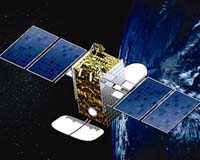 |
Paris, France (SPX) Sep 10, 2010 All space missions are difficult. Docking a pair of spacecraft is tough but flying multiple satellites together in formation is the real cutting edge. A new simulator is now allowing mission planners to get to grips with multi-satellite missions to come, starting with ESA's Proba-3. Several space agencies are preparing formation-flying missions, but it is hard to overstate the difficulty they face: separate expensive pieces of hardware, each one zipping through space at several kilometres per second, may have to manoeuvre to within metres of each other to achieve their goals. The relative positions of the satellites must be maintained precisely as they close in: lose control of one part of the formation, even momentarily, and the satellites risk destruction. And orbital dynamics dictate the satellites' orbits will tend to cross as they circle Earth, another worrying factor for their controllers. Even so, there are specific tasks only formation flying can do - and a new computing resource should help to achieve them. The Formation Flying Test Bed is a suite of software running across linked computers to simulate all aspects of a formation-flying mission. Overseen by ESA's Software Systems division at the agency's ESTEC space research and technology centre in the Netherlands, this new facility can emulate the running of more than a single satellite at once. "It is a generic simulator for formation-flying missions, whether they include two spacecraft or as many as five or six," explained Raffaella Franco. "Simulations are a computer-intensive business anyway, but trying to emulate more than one spacecraft's onboard computer and software simply will not run on a single computer, not to mention the rest of the satellite and the associated ground systems and inter-satellite links. "Instead, the Formation Flying Test Bed allows the distribution of software across multiple computers without affecting the user experience." The testbed addresses crucial operational factors for formation flying, including mission and vehicle management, guidance navigation, dealing with faults and communicating between satellites. The facility can also be used for training satellite controllers, preparing new procedures or even as a troubleshooting tool once a mission has made it to orbit. To help develop the testbed a demonstration model was created based on Proba-3, ESA's first formation flying mission, due for launch in 2014-15. Proba-3's two satellites will form the first 'external coronagraph' in orbit, with one satellite maintaining an artificial eclipse of the Sun as seen from the other, so that hidden details of the solar corona can be seen. The testbed was developed by Belgium's Spacebel, also responsible for Proba-3's flight software. The project was backed through ESA's General Support Technology Programme, which aims to mature prototypes into operational hardware.
Share This Article With Planet Earth
Related Links ESTEC space research and technology centre Space Technology News - Applications and Research
 Astrium And Avanti Communications Launch Military And Government Ka-Band Test-Bed
Astrium And Avanti Communications Launch Military And Government Ka-Band Test-BedParis, France (SPX) Sep 10, 2010 Astrium Services is launching its military and government advanced Ka-band test-bed in cooperation with Avanti Communications who will be providing the satellite bandwidth. Astrium Services has entered into a pioneering agreement with Avanti Communications to use transponder capacity for Ka-band tests on the soon to be launched Hylas 1 satellite. The technology test-bed comprises a dedicat ... read more |
|
| The content herein, unless otherwise known to be public domain, are Copyright 1995-2010 - SpaceDaily. AFP and UPI Wire Stories are copyright Agence France-Presse and United Press International. ESA Portal Reports are copyright European Space Agency. All NASA sourced material is public domain. Additional copyrights may apply in whole or part to other bona fide parties. Advertising does not imply endorsement,agreement or approval of any opinions, statements or information provided by SpaceDaily on any Web page published or hosted by SpaceDaily. Privacy Statement |